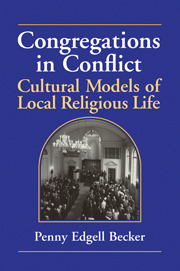Book contents
- Frontmatter
- Contents
- Tables
- Acknowledgments
- 1 “Who We Are” and “How We Do Things Here”: Local Understandings of Mission and Identity
- 2 The Congregations of Oak Park, River Forest, and Forest Park
- 3 Houses of Worship
- 4 Family Congregations
- 5 Community Congregations
- 6 Leader Congregations
- 7 Mixed Congregations
- 8 An Institutional Approach to Local Culture
- 9 American Congregational Religion
- Appendix A Data and Methods
- Appendix B The Interview Questions
- References
- Index
5 - Community Congregations
Published online by Cambridge University Press: 07 August 2009
- Frontmatter
- Contents
- Tables
- Acknowledgments
- 1 “Who We Are” and “How We Do Things Here”: Local Understandings of Mission and Identity
- 2 The Congregations of Oak Park, River Forest, and Forest Park
- 3 Houses of Worship
- 4 Family Congregations
- 5 Community Congregations
- 6 Leader Congregations
- 7 Mixed Congregations
- 8 An Institutional Approach to Local Culture
- 9 American Congregational Religion
- Appendix A Data and Methods
- Appendix B The Interview Questions
- References
- Index
Summary
At Bethlehem Congregational Church, “Congregational” means something very specific. When I asked one man, a highly involved lay leader in his forties who works as a midlevel manager at a downtown company, to describe what brings the church together, he emphasized themes that other members would talk about again and again:
It's a good congregational church. We do a good job of being driven by the interests and needs of the members. We don't have many cliques … and we'll confront each other, it's very confrontational. We'll confront all kinds of issues that other churches avoid. But the guiding principle is always to be more open, to include more people and more points of view, not to exclude.
He went on to tell me about a debate over whether to use Styrofoam or paper cups at the coffee hour, brought about by some people who “felt strongly about the environmental issue.” He said, ruefully, that a lot of energy was expended over what was in fact a small thing. Openness to all of the members' needs all the time can lead to exhaustive debate. He said that sometimes “We worry too much. We beat ourselves up over things.” Still, he is glad that this is a place where one or two people can start a public conversation over an issue that they care about.
- Type
- Chapter
- Information
- Congregations in ConflictCultural Models of Local Religious Life, pp. 101 - 125Publisher: Cambridge University PressPrint publication year: 1999



